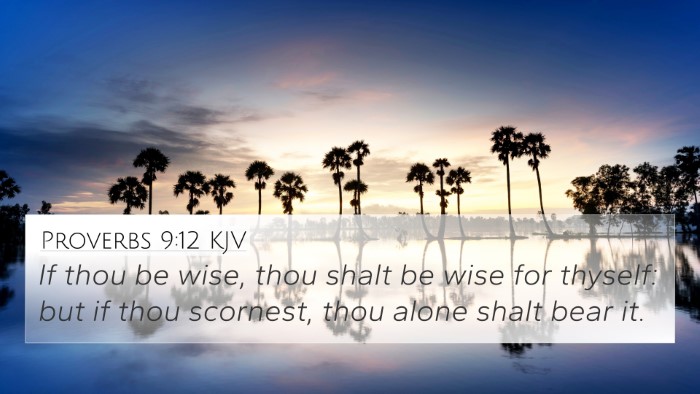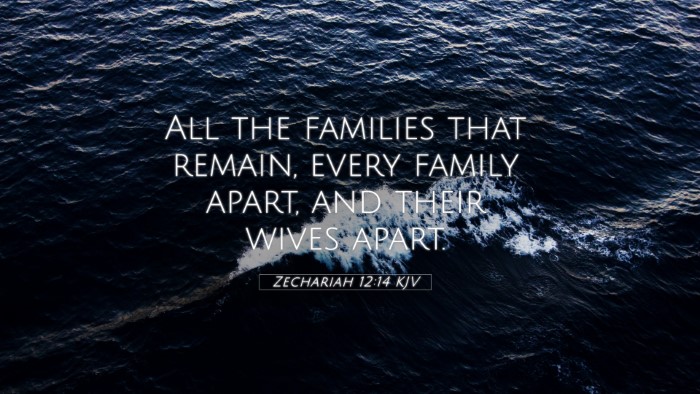Old Testament
Genesis Exodus Leviticus Numbers Deuteronomy Joshua Judges Ruth 1 Samuel 2 Samuel 1 Kings 2 Kings 1 Chronicles 2 Chronicles Ezra Nehemiah Esther Job Psalms Proverbs Ecclesiastes Song of Solomon Isaiah Jeremiah Lamentations Ezekiel Daniel Hosea Joel Amos Obadiah Jonah Micah Nahum Habakkuk Zephaniah Haggai Zechariah MalachiZechariah 12:14 Similar Verses
Zechariah 12:14 Cross References
All the families that remain, every family apart, and their wives apart.
Uncover the Rich Themes and Topics of This Bible Verse
Listed below are the Bible themes associated with Zechariah 12:14. We invite you to explore each theme to gain deeper insights into the Scriptures.
Zechariah 12:14 Cross Reference Verses
This section features a detailed cross-reference designed to enrich your understanding of the Scriptures. Below, you will find carefully selected verses that echo the themes and teachings related to Zechariah 12:14 KJV. Click on any image to explore detailed analyses of related Bible verses and uncover deeper theological insights.

Proverbs 9:12 (KJV) »
If thou be wise, thou shalt be wise for thyself: but if thou scornest, thou alone shalt bear it.
Zechariah 12:14 Verse Analysis and Similar Verses
Summary of Zechariah 12:14
Zechariah 12:14 states, "And all the families that remain, every family apart, and their wives apart." This verse reflects a significant moment of mourning and repentance, highlighting the profound experience of grief among the people of Israel over their past sins and the realization of the sacrifice of their Messiah.
Interpretation and Meaning
Based on the insights gathered from Matthew Henry, Albert Barnes, and Adam Clarke, the verse can be understood in several layers:
- The Context of National Mourning: The passage describes a time when the people of Israel will look upon the one they have pierced (Zechariah 12:10), leading to intense mourning akin to the mourning for a firstborn son (Barnes). This emphasizes their collective sorrow over their rejection of Jesus as the Messiah.
- Separation for Sorrow: The directive for families to mourn separately suggests a deeply personal and communal aspect of grief (Clarke). Each family must come to a realization of their part in the nation's sin, highlighting individual accountability within a national context.
- Prophetic Fulfillment: This text is seen as part of the prophetic fulfillment related to the coming of Christ and the future recognition of His sacrifice (Henry). The acknowledgment of their previous wrongs signifies a turning point toward restoration.
Cross References
To better understand Zechariah 12:14, here are some relevant Bible verse cross-references:
- John 19:37: “And again another scripture saith, They shall look on him whom they pierced.”
- Matthew 27:54: The centurion's declaration, “Truly this was the Son of God!” reflects recognition of the pierced Christ.
- Revelation 1:7: “Behold, he cometh with clouds; and every eye shall see him, and they also which pierced him…” indicating a future recognition and mourning.
- Lamentations 3:48-49: The sorrow expressed by Jeremiah illustrates a communal aspect of lamentation.
- Zechariah 13:6: “And one shall say unto him, What are these wounds in thy hands? Then he shall answer, Those with which I was wounded in the house of my friends.”
- Romans 11:26-27: Discusses all Israel being saved, touching on national repentance and redemption.
- Acts 2:37-38: The response of the crowds after Peter’s sermon signifies personal and communal recognition of their sin.
Connections to Other Scriptures
This verse serves as a bridge to various themes found throughout scripture, fostering connections between Bible verses:
- Thematic Bible verse connections: Themes of repentance and mourning run throughout the prophetic texts leading to the New Testament.
- Bible verses that relate to each other: Passages in the Gospels often reflect back on the prophetic traditions of the Old Testament.
- Comparative Bible verse analysis: Interpreting this verse alongside texts discussing the suffering servant (Isaiah 53) deepens understanding of the large narrative of redemption.
Tools for Bible Cross-Referencing
For those interested in further exploration, there are several tools for Bible cross-referencing:
- Bible concordance: Use a concordance to explore the Hebrew and Greek terms used in these passages.
- Bible cross-reference guide: Guides can help identify thematic connections and cross-references.
- Cross-reference Bible study: Engaging in studies that draw parallels can unveil deeper meanings.
Applying Cross-Referencing Strategies
To effectively study the Bible, consider these cross-referencing Bible study methods:
- Identify connections between Old and New Testament: This can yield insights into the continuity of God's plan.
- Detailed cross-reference between Gospels: Viewing similar accounts in different Gospel narratives can provide clarification.
- Cross-referencing Psalms with New Testament teachings: Explore how Psalms serve as a foreshadowing of New Testament events.
Conclusion
By understanding Zechariah 12:14 through the lens of public domain commentaries and cross-references, one gains a richer perspective on the sorrowful yet redemptive narrative of scripture. The personal and collective aspects of mourning in this verse echo the greater theme of recognition and repentance, leading toward divine restoration.


